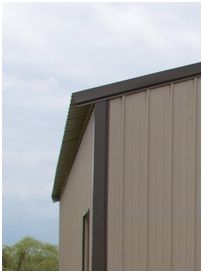The Rumors One Hears
Author’s Note: This is part 8 of a series of blogs written from a 6500+ motorcycle trip from WA to Ohio and back. See Blog from Oct. 15th for the beginning…and hang on for the ride!
I suppose not every customer walks into a lumberyard fully dressed in leathers. I have found it does have certain advantages, as most building materials dealer employees seem to either own a motorcycle now, previously, or want to in the future. It gives a common ground on which to bond from. 
After chatting up one motorcycle enthusiast on my “Zen” trip, I found out he formerly worked for the largest steel roll forming company in the United States. This company happens to also provide a considerable number of post frame building packages across their service area.
While we are talking, he happens to mention he has heard his former employer is providing steel roofing and siding for their buildings, in which they measure their steel thickness INCLUDING the paint! Now this could very well just be the grumblings of a former employee, or there could be some degree of truth to the story.
So how would one go about being able to determine if what they are being sold is actually what they think they are buying?
Outside Micrometer.
I did a search this morning and found outside micrometers available on EBay for as little as $22.95 plus shipping. Purchasing one to measure steel thickness could more than pay for itself, even when involving a very small building.
For those of you who are unfamiliar with how to use an outside micrometer, the following is provided courtesy of www.pgiinc.com:
Sleeve: The Micrometer sleeve is divided into 10 equal parts, each of these parts is equal to .100″ (1 tenth of an inch). Each of these 10 parts is divided into 4 equal parts. Each of these 4 subdivisions is equal to .025″ or one 40th of an inch. More simply, the line on the sleeve marked “1” represents .100″, the line marked “2” represents .200″ and so forth.
Thimble: The thimble is divided into twenty-five equal parts, each of these parts is equal to .001″ and, one complete rotation of the thimble coincides with the smallest division (.025″) on the sleeve.
| (1) Reading on the Sleeve | .200″ |
| (2) No. of lines between “2” and the edge of the thimble | .025″ |
| (3) Thimble line corresponding to the center line of the sleeve | .001″ |
| TOTAL READING | .226″ |
Steel thickness is measured before primer and paint are applied to the bare steel. The generally accepted thickness of the paint coatings systems should be approximately .0015 of an inch.
Shopping for a pole building kit package? If the proposed provider has some steel siding or roofing available, take your micrometer to it. If it is supposed to be 29 gauge, it should measure no less than .0157 including the paint. If it is less….you are paying for either less steel or thinner paint than what is being advertised!
For more information on steel thickness and steel gauges:
https://www.hansenpolebuildings.com/blog/2012/01/steel-thickness/






